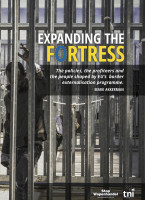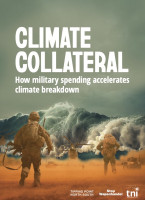How the EU has used the war in Ukraine to expand its border regime
Since Russia’s full-scale invasion of Ukraine in February 2022, more than 13 million people have been forcibly displaced from their homes in what the United Nations High Commissioner for Refugees called ‘the fastest growing refugee crisis in Europe since World War II’. Breaking with a policy of deterring and containing asylum seekers outside its borders, the EU and its member states rightly responded to the flow of people by creating legal pathways that granted Ukrainian nationals protection and legal status within the Union. To date, some 8.2 million Ukrainians have registered across Europe. While these laudable efforts have undoubtedly saved lives, over a year later it is clear that the measures are the exception and not the rule. The EU has used the war in Ukraine to expand its deadly border regime in Eastern Europe, in particular the role of Frontex, doubling its efforts to keep out those fleeing other wars and conflicts. Moreover, Ukraine, which has acted as the EU’s border guard for nearly two decades, has continued to play this role even as the war rages on.
As we approach World Refugee Day, we expose the discrimination, racism, and hypocrisy driving Europe’s deadly border policies in response to the war.
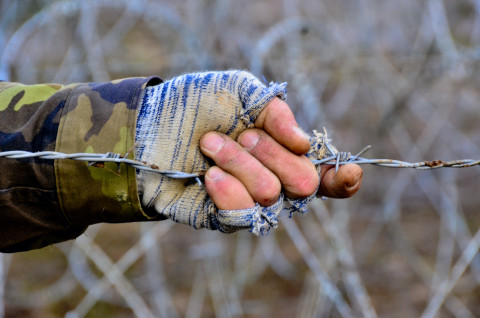
U.S. Government/CC0 1.0 Universal (CC0 1.0)
The EU’s differential treatment of refugees
Following the Russian invasion of Ukraine, millions of people fled the war by moving across Ukraine’s western borders with the EU. In response, the EU and its member states did something unprecedented – they created legal pathways that immediately permitted millions of refugees to live and work inside the Union. Meanwhile in the Mediterranean, where the EU and its member states have withdrawn Search and Rescue missions and criminalised civil society organisations (CSOs) that have stepped in to fill this void, at least 2367 people were left to drown throughout 2022, though the real figure is likely much higher.
A situation has unfolded since 2022 whereby the EU is willing to receive millions of refugees from one war-torn country but is hellbent on keeping those from other war-torn countries out. In one particular example in March 2022, Greece accommodated 18,000 refugees from Ukraine, but simultaneously illegally deported to Türkiye at least 540 refugees from Afghanistan, Algeria, Bangladesh, Egypt, Iraq, Libya, Morocco, Somalia, Syria, and Yemen, resulting in the death of a four-year-old child. Moreover, there were instances across Europe of refugees already living in state-provided accommodation being displaced to make space for Ukrainians.
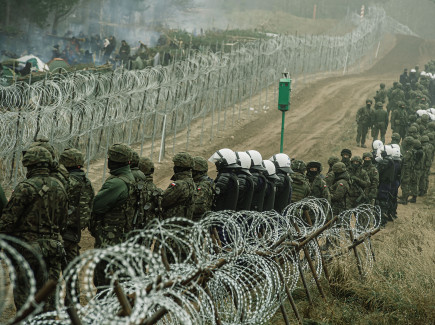
Irek Dorozanski DWOT/ Flickr/CC BY-NC-ND 2.0
Perhaps Poland represents the starkest example of the hypocrisies that have emerged in the wake of the war. People fleeing Ukraine were received with warm meals, blankets, and provided with shelter, whereas further north along the Polish-Belarussian border people fleeing wars in Afghanistan, Iraq, and Syria, among other countries, were quite literally hunted like animals by border patrol dogs, or allowed to freeze to death in the vast forests of Poland’s north eastern territory.
In national debates across many EU member states, politicians have used the presence of Ukrainian refugees to spin racist-driven arguments that Europe is full, in some cases advocating that non-Ukrainian arrivals, the vast majority of whom are not white, should be refused entry or deported. Britain’s much-criticised ‘Rwanda Plan’, which seeks to immediately deport to Rwanda those arriving ‘illegally’, is part of a much larger trend across Europe dating from long before the Ukraine war, of stepping up deportations and simultaneously eroding International Refugee Law. European states have used the war in Europe as a pretext to fortify their borders while driving a wedge between refugees who are considered deserving of protection – Ukrainian nationals – and others, often from other war-torn nations, who are not.
Separately, many of Europe’s political leaders have made clear that those attempting to flee Russia’s forced conscription orders will not be granted refuge in the EU. In this vein, Finland, Poland, and the Baltic states have begun building new fences and further militarising existing infrastructure along the EU–Russian border, making it more difficult for Russians who are fleeing forced mobilisation or the wave of repression unleashed against those protesting the war to seek asylum in the EU.
Differences even among those fleeing Ukraine
Differential treatment with regard to international protection was not only observed between those fleeing the war in Ukraine and other wars. Hierarchies have also emerged between those fleeing Ukraine. The Ukrainian authorities prohibited Ukrainian men between 18 and 60 years of age, as well as trans-women, from leaving, insisting instead that they join the war effort. Non-Ukrainian nationals or those whose status in the country prior to the outbreak of war was irregular faced significant obstacles in securing protection in the EU.
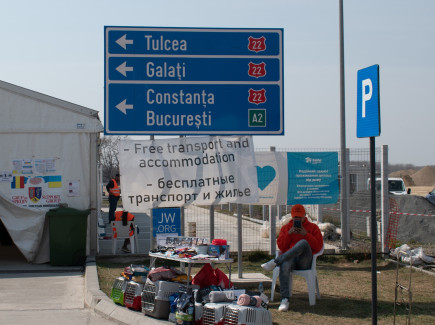
Marco Giarracca, Jesuit Refugee Service on Flickr
In one of the most shameful examples of how a two-tiered approach was applied by the EU and Ukraine with regard to those fleeing the war, dozens of non-Ukrainian nationals were held in an EU-funded detention centre inside Ukraine, as the war raged around it. This is a clear violation of International Refugee Law and International Humanitarian Law, in particular Article 58C of Additional Protocol 1 to the Geneva Conventions.
The Volyn PTPI, located less than 40 kilometres from a military airfield that was bombed by a Russian airstrike in March 2022, refused to release between 35 and 45 detainees from Afghanistan, Bangladesh, Cameroon, India, Pakistan and Sudan. Five Ethiopians were released and relocated to Romania only after their government intervened. While most of the original detainees were eventually released following international pressure, the fact that not all had legal status in Ukraine led to some of them being detained once again in Poland. The incident speaks for itself—at a time when millions of Ukrainian refugees were entering the EU, 45 non-Ukrainians desperate to flee the same war remained locked up in an EU funded detention centre to keep them out.
This detention centre remains operational today and the detainees are mainly political refugees from surrounding countries whom the Ukrainian government deems suspicious (pro-Russian) solely on base of their nationalities. According to the Global Detention Project ‘it is also alarming that Russians, Tatars, Dagestanis, Azerbaijanis, Armenians, and Uzbeks, many of whom have fled persecution by Russian security services and whose lives and safety would be in extreme danger if deported to their countries, are being arrested, detained, and threatened with deportation from Ukraine’.
Since the mid-2000s, the EU has funded the construction of detention centres located deep inside Ukrainian territory where those heading towards the EU, or deported from it, have been held. Under the terms of a 2008 agreement, Ukraine was ‘expected to receive a considerable number of irregular migrants from third countries who managed to enter the EU’s territory from Ukraine, having used Ukraine as a transit country’. Three years before this agreement was signed, in 2005, Human Rights Watch had already highlighted the ‘continuing pressure on Ukraine from the EU to assist in migration management and border enforcement’. Moreover, human rights organisations and the international media denounced the use of torture, inhumane and degrading treatment inside these centres, including applying electric shocks and beating detainees. Despite credible allegations of torture, the EU continued to enact and implement bilateral agreements with Ukraine to contain those on the move outside its borders.
Frontex Expands
In early 2022 Frontex launched ‘Joint Operation Terra 2022’, deploying officers from its newly established standing corps to dozens of border crossings across 12 EU member states. Once the war intensified across Ukraine, the presence of these border officials and the use of aerial surveillance equipment at the EU borders with Ukraine and Russia was expanded, particularly in Estonia, Romania and Slovakia. Following much scrutiny and criticism of its role in illegal deportations in the Aegean Sea, among other human rights violations, the war offered Frontex the opportunity to clean up its image. Photos of Frontex border officials handing out teddy bears to Ukrainian children were shared on the agency’s social media accounts, together with commentary about the importance of keeping families united while fleeing war. The agency deployed a selective approach in dealing with those fleeing Ukraine. While Ukrainian nationals were permitted entry to the EU, those from other countries who found themselves in Ukraine when the war broke out faced significant hurdles to secure temporary protection and were offered ‘voluntary return’, though in many cases returning to their home countries was out of the question.
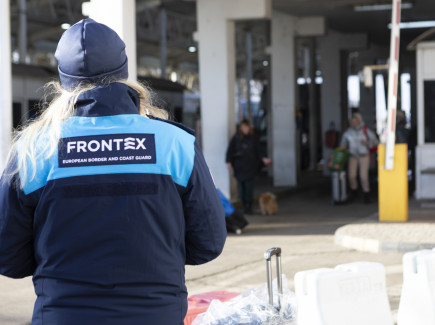
Dipertimento Protezione Civile/Flickr/CC BY 2.0
In July 2022 the EU launched its Support Hub for Internal Security and Border Management in Moldova to coordinate its support to the country in light of the Russian invasion of Ukraine. Frontex plays an important role in this context and also concluded its own agreement that saw the deployment of officers and donations of border-security equipment to Moldova to ‘support the reception of refugees from Ukraine’. The fine print of the agreement also included strengthening border security and fighting irregular migration. Very quickly this more securitised approach to dealing with those seeking refuge took precedence over providing humanitarian assistance. Over a year on, Frontex is no longer sharing images of its officials handing out cuddly toys to children, but it has reverted to its usual operations, boasting that ‘in 2022, joint Frontex and Moldovan border police teams achieved excellent results … record[ing] a 300 percent increase in the detection of irregular migration compared to 2021’.

Frontex on Twitter
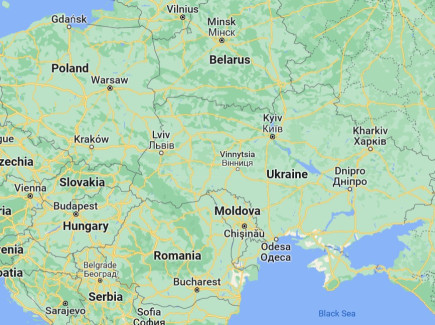
Google maps
Separately, since the full-scale invasion, CEPOL, the EU Agency for Law Enforcement Training, organised a study visit to Lithuania on ‘illegal immigration’ for law enforcement officials from Ukraine and Moldova and hosted a course on the same issue for its Moldovan partners. In February 2023, on the initiative of Estonia and the US, representatives of regional donor countries gathered at the Estonian Embassy in Warsaw to exchange ideas on how to best upgrade Ukraine’s border guard to meet EU requirements. Accession to the Schengen Area, albeit still a long way off, would lead to even more demands from the EU, with funding from the Instrument for Pre-Accession Assistance (IPA) to be made available for border security and control.
The outsourcing of EU border control is not new, but rather is part of a well-oiled strategy of border externalisation and should be understood in that context. In its conclusions to a special meeting in February 2023 the European Council reaffirmed plans to drastically increase the pressure on third countries to cooperate in deportations and readmissions, with Frontex playing an important role. In what appears to be an attempt to justify the ongoing crackdown on migration, the Council conclusions referred to the ‘instrumentalisation’ of migration ‘as part of hybrid destabilising actions’. Even before the war the EU had accused Russia and Belarus of ‘weaponising’ people on the move by directing many of them at once to the Polish border with the aim of ‘destabilising’ the EU and its partner countries. This narrative of ‘weaponisation’ wrongly depicts people in need of protection as ‘enemy weapons’. It is an escalation of the ’migrants as threats’ narrative that has long underpinned EU border and migration policies and has effectively been used to disable the right to asylum in certain places – and also justify the call for ever more draconian border militarisation.
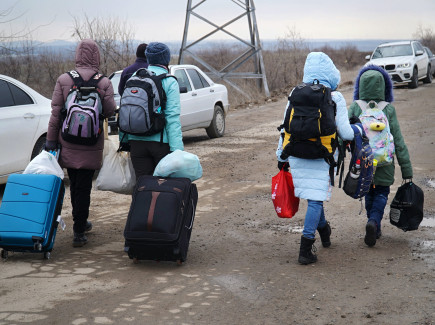
UN Women/Flickr/CC BY-NC-ND 2.0
The arms spending will clearly benefit the arms industry. Proposals to simplify intra-EU transfers of arms components and ease restrictions on exports of weapons systems to non-EU countries would pave the way to more exports of border security equipment, and arms in general, to countries at war and repressive regimes.
While the war in Ukraine has not only led to massive loss of life, immense suffering and destruction across the country, its effects can also be felt all over the globe. It has severely affected food and fuel supplies, driving up prices and creating shortages. Massive inflation, fuelled by corporate profiteering – and the ‘greedflation’ of shareholders – has plunged ever more people into poverty. On top of this, the environmental destruction and the impact of the war on climate change stretches far beyond the borders of Ukraine. Research has shown that the military overall generates some 5% of global carbon emissions. These effects combined will increase forced displacement, especially in the Global South. In turn, this can be expected to lead to calls for more border fortification, in an endless cycle triggered by the EU’s tunnel vision of a securitised and militarised response to migration. The military and security industry, already feasting on the current spending bonanza, will be the main profiteer of these destructive policies of Fortress Europe.
Conclusion
Somewhat obscured by the EU's comparatively generous reception of (white) refugees from Ukraine, it has quietly used the war and its consequences to rapidly boost and militarise border security, with a lead role for Frontex that has seen its operational mandate expanded far beyond the EU. Refugees fleeing other countries and conflicts as well as people on the move still detained or living in Ukraine have borne the brunt of this.
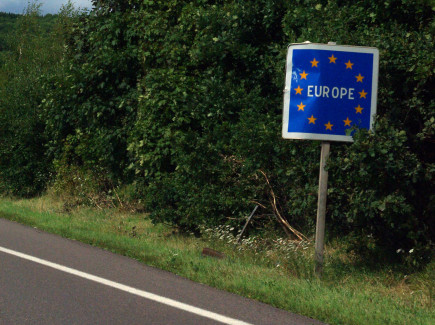
Will Bakker/Flickr/CC BY-SA 2.0
The EU’s response to the war in Ukraine has shown that when there is political will, it can immediately and effectively create legal pathways permitting refugees to live safely within the EU. The fact that it failed do so for refugees fleeing other war-torn regions has exposed the discrimination, racism, and hypocrisy that drive the EU’s deadly border regime. This regime will be further intensified with the agreement reached on June 8 between EU member states on the Pact on Migration and Asylum, which reduces protection standards, erodes the rights of people on the move, and opens the door for more detention, illegal deportations, and border externalisation.
If the EU is truly invested in tackling the root causes of migration and not just containing it beyond its borders, perhaps cutting ties with authoritarian regimes and curtailing arms exports to countries at war would be a good place to start. The EU and its member states are legally bound under international law to treat all those who seek asylum equally, regardless of the colour of their skin or their country of origin.
Rather than spending pools of public money on fuelling wars and fortifying borders, the EU and its member states should instead support communities and local networks in their efforts to receive those fleeing war and violence.



